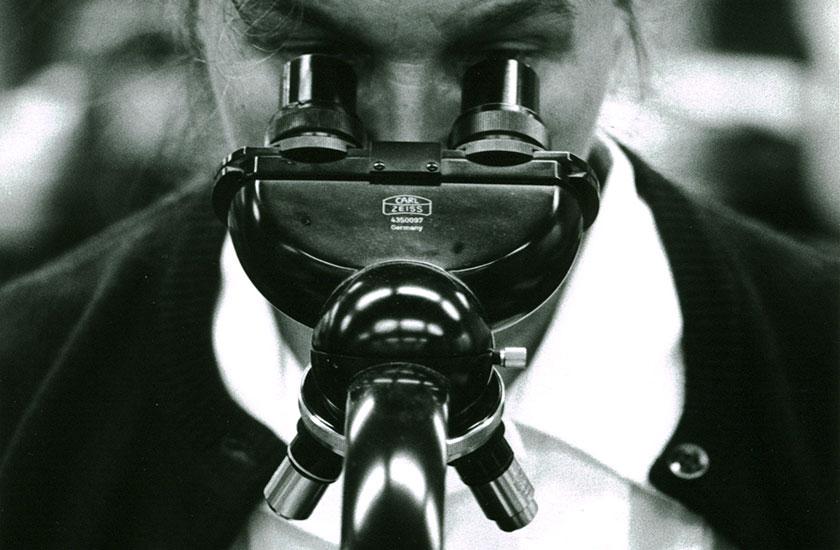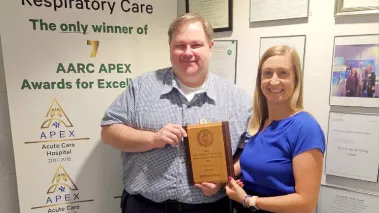After giving a blood or urine sample at the doctor’s office, you get a call or message about your test results. Maybe you find out about something — like higher cholesterol or lower blood sugar — that you weren’t expecting. Or maybe you finally get a diagnosis you’ve been seeking.
Many of us have had an experience like this. But few of us know exactly how our test result was determined. “It’s kind of like when you go to the store and you see all the merchandise on the shelves,” says Maribeth Flaws, PhD, MLS (ASCP)CM SM, SI, director of the Master of Science in Medical Laboratory Science program in Rush University's College of Health Sciences. “You’re not thinking about all of the steps that it takes to get there.”
Flaws, on the other hand, spends her days thinking about everything that goes into analyzing tissue specimens from patients, reporting the results back to physicians and nurses, and helping those clinicians decide which tests to order in the first place. Her program trains scientists to staff the hospital labs where all this vital diagnostic work happens. And that’s just one of the jobs graduates leave prepared to do.
One of the first of its kind to offer a master’s degree, the laboratory science program is now celebrating its 60th anniversary. As it builds on a long history of leading the discipline, it’s preparing graduates to shape the future.
Leading the way in a changing field
The program has existed since at least 1959. Its initial home was Presbyterian-St. Luke’s Hospital, which became Rush-Presbyterian-St. Luke’s Medical Center in 1969 and then Rush University Medical Center in 2003.
Like other laboratory science programs in the 1950s and ‘60s, it didn’t grant degrees. Students completed a yearlong internship, learning what they needed to know on the job. When Rush University was founded in 1973, the program bulked up its curriculum to become what Flaws calls a “two plus two” program. Students would do two years of college work at another school and then come to Rush for their last two years to earn a bachelor’s degree.
In the meantime, medical laboratory science was rapidly advancing. “We’ve gone from maybe 100 total laboratory tests in 1959 to thousands today,” Flaws says. “And the technology has totally transformed.”
DNA- and RNA-based tests, in particular, have revolutionized the field. “Back in 1959, we could tell that a patient with cancer had too many white blood cells, and too many lymphocytes, but that’s about all,” Flaws explains. “Now, with molecular-based tests, we can say that particular tumor cells have a particular mutation, and that having the mutation makes those cells susceptible to a particular drug.”
This kind of knowledge can help physicians individualize treatments for their patients. But clinicians don’t always know which tests, among the thousands available, will give them the precise answers they need. So medical laboratory scientists now need to be able to guide physicians, helping them figure out which tests are most appropriate and what the results mean.
In recognition of this increasingly specialized expertise, Rush replaced its bachelor’s program with a master’s program in medical laboratory science in 2000, becoming one of the first universities to do so.
“The master’s degree is more representative of what students have to learn,” Flaws says. “They really have to come in already having a solid science background.”
Unique ways to help people (and sometimes animals)
Nicholas Moore, PhD, MLS (ASCP)CM, had exactly that kind of background when he came to Rush in 2007 after receiving a bachelor’s degree in investigative and medical sciences from Saint Louis University. He chose Rush’s MS in Medical Laboratory Science program because he wanted to, as he puts it, “take my love of science and help people without becoming a physician or a nurse.”
That’s exactly what he went on to do. After graduating, Moore took a job in the core and microbiology laboratories at Rush before moving on to become the lab manager at a long-term acute care hospital. “I remember being very nervous about what I thought was such a big leap,” he recalls. “But I felt very prepared thanks to my education.”
Eventually, in the midst of completing the PhD in Health Sciences program at Rush University, he moved on to a role with even greater responsibility: He’s now the assistant director of the Division of Clinical Microbiology in the Department of Pathology.
Flaws says that most graduates, like Moore, go on to work in hospital laboratories. But many other options are available. Some graduates with an interest in computer science help develop the computers or software programs that lab scientists use to interpret tests. Others work in sales, customer training or product development at companies that produce diagnostic testing tools.
“I’ve even had graduates go on to work at the zoo because the testing that’s done on animals is very similar to what we do in humans,” Flaws says.
Many students also pursue PhDs. “This is of paramount importance as the technology and testing is changing so rapidly, becoming much more complex,” says Moore, who finished his PhD at Rush two years ago. “To help improve efficiencies and reduce unnecessary health care costs, laboratory scientists need to be the champions and leaders of diagnostic stewardship.”







